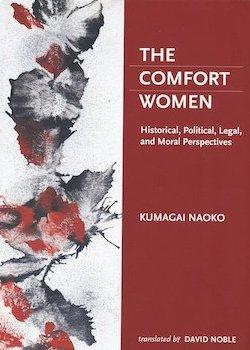The Comfort Women: Historical, Political, Legal and Moral Perspectives

By Kumagai Naoko
Translated by David Noble
LTCB International Library Trust/International House of Japan, 2016
ISBN: 978-4 924971-42-4
This book is an English translation of Ianfu mondai, originally published by Chikuma Shobo (2014)
Review by Sir Hugh Cortazzi
The ‘Comfort Women’ remain a contentious issue especially between Japan and South Korea. This book, which looks soberly at the various perspectives of the problem, is a valuable contribution to our understanding of the issue.
Kumagai Naoko first sets out the ‘points of contention’ and goes on to discuss the facts that can be firmly established. She asks ‘how much free will did the comfort women have’ and the extent of coercion exercised by the Japanese military authorities. She looks at the problem in the context of sexual violence in war and occupation. She also considers the historical background and officially licensed prostitution in Japan.
In Chapter Three, she considers where responsibility for the suffering of comfort women lies and ‘why Japan’s military regulations did not prevent rape and enforced prostitution’. This leads on to a discussion in Chapter Four, of the Asian Women’s Fund and Japan’s moral responsibilities. In this, she compares Japan’s response with the German Foundation ’Remembrance, Responsibility, and Future’.
Chapter Five concentrates on the evolving concept of women’s human rights. In the Final Chapter she seeks for a way to achieve genuine reconciliation.
The author notes that the comfort women issue first emerged as a political controversy at the beginning of the 1990s. Why did it take so long after the end of the war to become contentious and why has it remained so hot a subject compared for instance to the treatment of allied prisoners of war or the misery and destruction caused by Japanese forces in China and the territories occupied by Japan in the Pacific War? Kumagai Naoko does not confront these questions directly, but one reason was surely the legalistic approach at first adopted by the Japanese government in order to limit its obligations to pay compensation. This was compounded by Japanese insensitivity to what was a highly emotional issue especially for the Korean women who had been coerced into becoming sex slaves for the Japanese military. Feelings in Korea were also incensed by the attempt of Japanese historical revisionists to rewrite the history of the Japanese aggression in Asia.
Kumagai Naoko notes (page 6) that when the issue was raised in House of Councillors in June 1990 the Japanese ministry of labour asserted that comfort women had been recruited by private sector entrepreneurs and it was ‘beyond its capacity to investigate the matter’. This was not accurate. There had been comfort stations operated by the Japanese military. The women were supposed to be paid for their services but it seems clear that many ‘did not actually receive the money they were owed’ (page 29).
The majority of the comfort women were Korean or Japanese although people of other races and nationalities were involved in occupied territories. Kumagai rejects the argument made by some Japanese conservatives that comfort women should be equated with licensed prostitutes. She also contests arguments based on Japanese military regulations, which paid scant attention to adherence to international law.
The crucial statement of 4 August 1993 by Kono Yohei on comfort women (reproduced on pages 98 and 99) acknowledged the involvement, direct and indirect, of the Japanese military in the establishment and administration of the comfort stations as well as in the recruitment of the women involved. She notes that Japanese prime ministers Hashimoto Ryutaro, Obuchi Keizo, Mori Yoshiro and Koizumi Junichiro issued letters of apology which expressed personal remorse and contrition, but these were not regarded as a sufficient acknowledgement of the Japanese government’s responsibility for the comfort women system and hence of a legal obligation to pay compensation.
Kumagai concludes (page 178) that the Korean demand for ‘sincerity’ from Japan stems from the fact that they do not sense integrity and consistency in Japan’s apologies, because ‘it is unclear what the apologies are for’ and because they are sometimes accompanied by ‘controversial remarks appearing to justify Japan’s past actions.’ She understands the Korean demand for ‘uncovering the historical truth’. In order to achieve a fundamental resolution of the comfort women issue she urges that it should ‘be understood as an issue of individual human rights’.

